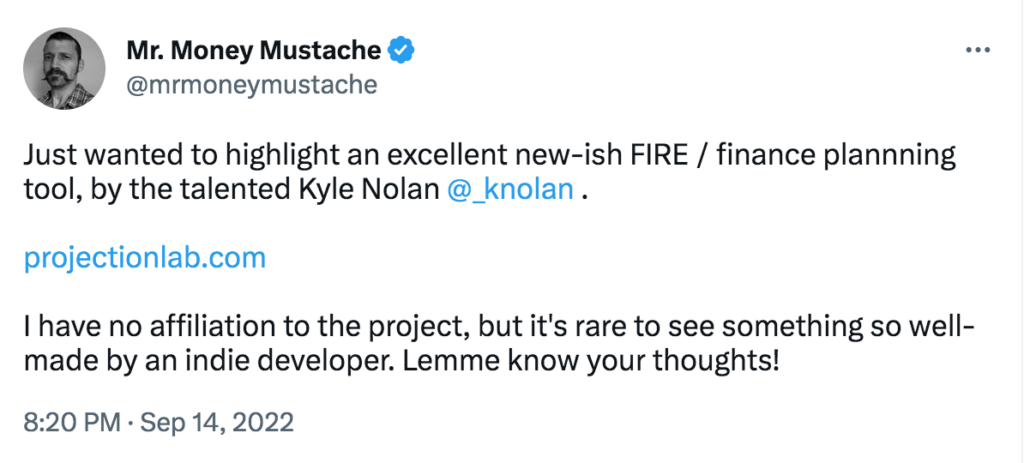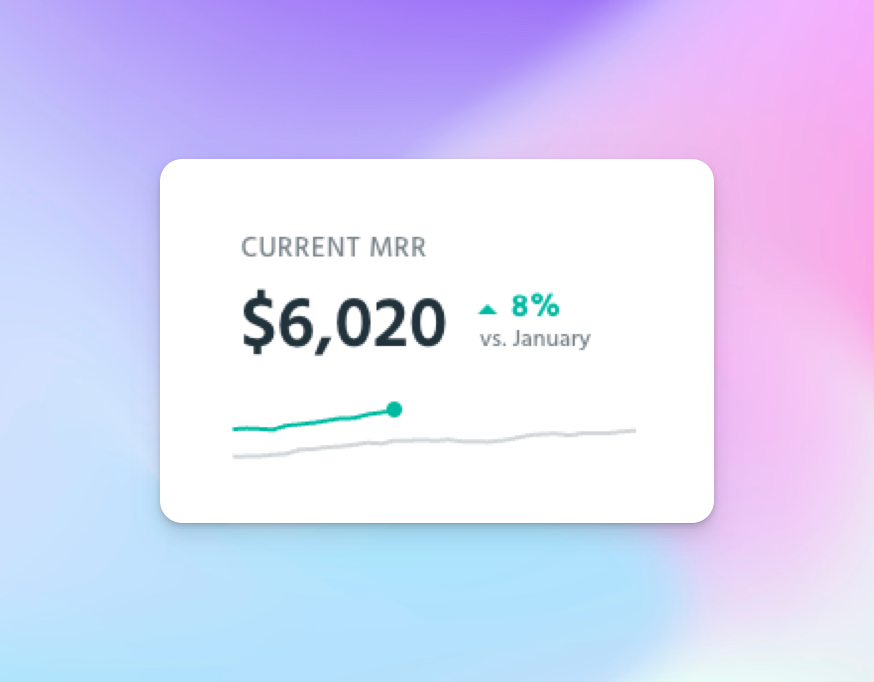AFFILIATE MARKETING
How This 30-Year-Old Grew His Financial Planning Tool to $6k/Month WITHOUT Marketing or SEO

Kyle Nolan got the entrepreneurial bug early on in life. That spirit, together with the discovery of the Financial Independence movement and unsatisfactory search for a financial planning tool, led him to start his current side hustle, ProjectionLab.
For about 2 years, he has been working nights and weekends to develop this financial planning tool all by himself. Currently, he’s bringing in $6k per month and building a small but loyal community of dedicated users. And the adventure has only just begun.
Keep reading to find out:
- What happened when he discovered the FI movement
- How ProjectionLab works
- How he grew it without marketing it
- How growth in sales has evolved over time
- How much time he spends on his business
- His thoughts on SEO
- Which resources and tools he recommends
- His biggest challenge
- His greatest accomplishment
- His main mistake
- His advice for other entrepreneurs
Meet Kyle Nolan
Hey, I’m Kyle. I’m a software engineer from Boston who likes scuba diving, fishing, reading, and hiking… well, last I checked, at least. For the past two years, I’ve spent most of my free time bootstrapping ProjectionLab to $6k MRR as a side project and solo developer.
I just turned 30 this year, and ever since I was a kid, I’ve been passionate about making things. In elementary school, I remember learning excel to create a (terrible) trading card game and sell packs to other kids in the neighborhood. In middle school, I started coding video games, and since then I’ve always had a personal project or two on the side.
Nothing matches that feeling of taking something that’s just an idea in your head and manifesting it in the real world. It will always feel a little like magic. And with side projects, it’s refreshing and liberating to have full creative control, no stand-up meetings, no sprint retrospectives, no changing requirements, and no funding to worry about
ProjectionLab started as one of these creative outlets. I didn’t even have monetization in mind at the beginning.
Over the past 20 years, I’ve accumulated a pretty colossal graveyard of video games and personal projects. However, as people signed up for PL and feedback poured in, it became clear that this was destined for a different fate!
Having a growing and supportive community of users is really energizing, and even though my work is still scoped to nights and weekends while it’s a side project, I’m more than happy to devote those hours because it really doesn’t feel like work.
Why He Created ProjectionLab
Before I discovered the financial independence movement, I often grappled with the feeling that there should be more to life than working until you’re too old to enjoy it.
Does sacrificing the best hours of the best days of your best years to meetings, briefings, and bureaucracy really add up to your best life?
I’ve witnessed how lifestyle inflation, bad planning, and unforeseen events can keep people trapped in that pattern forever. So when I discovered the books and blogs of FI community legends like J.L Collins, Pete Adeney, Morgan Housel, and Grant Sabatier, I realized that I needed to start actually taking control of my financial future. I wanted to know that someday I could have the freedom to be my best self all the time, not just when I’d saved up enough PTO for a vacation.
Theory is nice, but I wanted a hands-on and visual way to map out all the options and explore the trade-offs between different life plans. So, I went looking for a good long-term planning and forecasting tool. Something modern, fluid, nuanced, and actually fun to use.
But somehow, that search for the perfect financial planning tool spiraled out of control… before I knew it, I was building a new one instead.
And after a couple of thousand hours of coding over the past two years of nights and weekends, I created ProjectionLab.
You can create beautiful financial plans with a level of nuance and flexibility that exceeds the standard online retirement calculators, run Monte Carlo simulations, backtest on historical data, review detailed analytics for estimated taxes, plan how to live life on your terms, and with any luck, reduce anxiety around your finances.
There’s a free sandbox if you want to see how it works quickly, it does not ask to link your financial accounts, you don’t have to create an account to try it, it works pretty well for international scenarios, and it respects your data.
As a solo dev building a fairly complex software solution as a side project, I’ve had a product-first approach by necessity, and it took several months just to create the MVP.
There were a grand total of 0 paid users when I posted it to Hacker News on a whim. I closed the tab, expecting that to go nowhere, and then came back an hour later to discover my email inbox was blowing up. I was astonished that the post had made the front page and more than a dozen people had signed up for premium.
Everyone always talks about how incredible it feels to make your first dollar on the internet… and in my experience, they’re right!
The fact that the MVP was actually a hit with the famously critical HN community lit a fire under me, and I doubled down on building out the app and adding everything people wanted to see.
Sometime in the following weeks, it reached 100 paid users, and organic/ word-of-mouth spread, coupled with the occasional post to places like r/SideProject, gradually propelled it into the low hundreds.
Since then, my pattern has been: to spend basically all my time with my head in the sand developing cool new features, occasionally picking it up to create a post somewhere like Reddit or HN, and also nurturing a community of users who love the tool.
I know the “spend all my time on development” part contradicts much of the conventional SaaS business advice. Still, this may be one of those rare cases where a laser focus on the product before marketing has been a good thing overall.
By scaling up the user base gradually, I’ve been able to avoid drowning in support requests and preserve the free time I’ve needed to re-architect and redesign the product several times before arriving at the more polished solution it is today.
Over the past few months, I was lucky enough to have some unexpected developments help to spread the word even more and close the remaining distance from ~750 paid users to the 1k mark:By scaling up the user base gradually, I’ve been able to avoid drowning in support requests and preserve the free time I’ve needed to re-architect and redesign the product several times before arriving at the more polished solution it is today.
– Pete Adeney (a.k.a. Mr. Money Mustache) gave PL a shout-out on Twitter

– Rob Berger (the author of Retire Before Mom and Dad) created a video review.
– Cody Berman and Justin Taylor, who run The FI Show, asked me to come on their podcast.
How Much Money Kyle is Making
ProjectionLab just crossed $6k MRR.

It took about 22 months to reach $6K MRR
→ 9 months to get to $1,000
→ 4 months to get to $2,000
→ 7 months to get to $5,000
→ 2 months to get to $6,000
Here’s a look at how the paid user base has grown over time:

How Many Hours a Week Kyle Spends on his Business
For now, I am building ProjectionLab as a side project. The breakdown for an average week looks something like:
Weeknights: 8pm to midnight
Weekends: ~10 hrs per day
So, around 40 hrs per week in total, on top of a full-time job.
I guess now is the part where you go “Oh, okay, so this guy just has no life.”
Well, side projects certainly have their pros and cons. The best part is the risk reduction. If you were to leap to full-time right away instead, I bet that liberating feeling of having complete creative control gets overpowered pretty quickly when it hits you that “this better work.”
But the worst thing about side projects is that they force you to sacrifice more of your most precious non-renewable resource: time.
The hard truth is that burning the candle at both ends means you rarely have time for everything you want to do in life. Something has to give. For me, that was playing video games.
I still carve out the time to exercise daily and try to do at least one fun social thing per week, but I also used to have a group that would play games regularly. That was my favorite way to stay in touch over long distances.
But the math just didn’t work while trying to bootstrap a complex technical project on the side. Some day in the future though, maybe I will come out of video game retirement and rejoin the squad.
Kyle’s Top Marketing Strategy
After validating the idea with PL version 1.0, the main thrust of my efforts has simply been to make the product so dang good that, eventually, people in this space can’t help but take notice. Maybe that’s finally working a little bit.
His View on SEO
I’ve barely thought about SEO and have no discernable content strategy. So yeah… you could say there’s plenty of room for improvement on the marketing side.
The primary focus has been to invest my extremely limited time in a way that (hopefully) manufactures some luck and exposure as a byproduct of creating a standout software solution.
But even though PL has been steadily growing over the past couple of years, I always remind myself that a mediocre product with great marketing often beats a great product with poor marketing. So at some point, I need to think more seriously about creating a reliable and sustainable long-term growth engine.
His Email List
I have an email list with a couple of thousand members, but one of my mistakes was implementing the “subscribe to newsletter” option late in the game. That should have been a part of the app since day one, not added a year late!
Kyle’s Favorite Resources
For those who have an interest in financial independence, here are a few of my favorites:
- The Simple Path to Wealth, by J.L. Collins
- The Psychology of Money, by Morgan Housel
- A Random Walk Down Wall Street, by Burton Malkiel
- Retire Before Mom and Dad, by Rob Berger
- Financial Freedom, by Grant Sabatier
Or, if you’re an indie developer looking to create your own app, here’s a tech stack that has served me well: Vue.js, Vuetify, Chart.js, Paddle, Firebase, and GCP.
His Top 3 Tools
Using a modern, component-based web development framework with a good material UI library (in my case Vue.js and Vuetify) has enabled me to rapidly build engaging and responsive interfaces that users actually enjoy spending time in.
I chose Paddle for my subscriptions and billing platform, and so far, that’s been smooth sailing.
Initially, Stripe lured me in with their excellent UX and developer APIs. But as a solo dev with serious time constraints, I wanted a full merchant of record solution that would handle all the complexities of collecting and remitting sales tax, VAT, etc. So at the end of the day, Paddle was the easy choice.
I also used Changemap to create a free public roadmap where anyone can suggest new features and vote. I set up a Discord server which has steadily been growing into a thriving community where people can ask questions, give feedback on the latest features in early access, and chat about personal finance and other topics with folks who share similar interests.
His Biggest Challenge
Given limited time, how to decide what to build and what not to build.
I always have a notional roadmap in my head, and it’s always being revised and rearranged based on:
- What is the community asking for right now? What topics keep coming up again and again in Discord/email?
- What are the most upvoted features on the public roadmap?
- What did I originally think I would be doing next?
- What do I actually **feel** like doing next? What would I be most energized and inspired to work on?
As I toss all the ideas around, I’ll usually try to add weights to them based on:
- Estimated level of effort/time required
- Chance to delight existing users and keep them around
- The prospect of spurring new growth
- Opportunity to reduce technical debt
- Feature “coolness factor”
- Chance to further differentiate from other products
- Opportunity to build new skills and knowledge
His Greatest Accomplishment
The simple ability to stick with projects long enough to finish them, release them into the world, and give them a chance to grow.
It’s common among developers to start lots of projects, but ship very few. It’s easy to get halfway done, run into some edge cases, and then just move on to the next shiny idea or technology.
But you won’t hit any of the larger entrepreneurial milestones if you can’t commit to a vision long enough to get something out the door.
What He Wishes He Knew When He Started
I wish I had known about the importance, and compounding effect, of building an audience.
You can have the best product in the world, but it won’t go anywhere if you can’t get enough eyeballs on it.
You want to start building a following and a user community as soon as possible.
Kyle’s Biggest Mistake
For a few months during the middle of my journey with PL, I was working on a major overhaul and putting in an unsustainable number of hours. Time is a zero-sum game, and I was letting sleep and exercise take the hit… and my vitals started to reflect that.
Beyond all the tips and tricks, you need to take care of yourself first and foremost.
Launching and growing a small startup requires consistency and persistence. And luck. And a bunch of other things.
But the point is: it’s a marathon. So only burn the candle at both ends when there’s a tactical reason. And always make time to exercise! What’s the point of working towards a better future if you might not be around to enjoy it?
His Advice for Other Entrepreneurs
If you’re just starting your own journey or contemplating a new project, here’s a small piece of advice from my experience so far:
Try to find a problem you understand deeply and truly care about solving, and build something that you’ll actually be a user of.
There are often more hurdles on the path to finishing and launching a project than you can predict going in; but if you really have that desire to see and enjoy the final product yourself, you can use that to help power through some of the obstacles.
It’s a lot easier to pursue an idea with persistence when you’re working on something you love and that you personally can’t wait to use.
AFFILIATE MARKETING
Samsung: 6-Day Workweek For Execs, Company in Emergency Mode

Four-day workweeks might have all the buzz, but one major tech company is going in the opposite direction.
Samsung is implementing a six-day workweek for all executives after some of the firm’s core businesses delivered lower-than-expected financial results last year.
A Samsung Group executive told a Korean news outlet that “considering that performance of our major units, including Samsung Electronics Co., fell short of expectations in 2023, we are introducing the six-day work week for executives to inject a sense of crisis and make all-out efforts to overcome this crisis.”
Lower performance combined with other economic uncertainties like high borrowing costs have pushed the South Korean company to enter “emergency mode,” per The Korea Economic Daily.
Related: Apple Is No Longer the Top Phonemaker in the World as AI Pressure and Competition Intensifies
Executives at all Samsung Group divisions will be affected, including those in sales and manufacturing, according to the report.
Samsung had its worst financial year in over a decade in 2023, with the Wall Street Journal reporting that net profit fell 73% in Q4. It also lost its top spot on the global smartphone market to Apple in the same quarter, though it reclaimed it this year.
Though employees below the executive level aren’t yet mandated to clock in on weekends, some might follow the unwritten example of their bosses. After all, The Korea Economic Daily reports that executives across some Samsung divisions have been voluntarily working six days a week since January, before the company decided to implement the six-day workweek policy.
Entrepreneur has reached out to Samsung’s U.S. newsroom to ask if this news includes executives situated globally, including in the U.S., or if it only affects employees in Korea. Samsung did not immediately respond.
Research on the relationship between hours worked and output shows that working more does not necessarily increase productivity.
A Stanford project, for example, found that overwork leads to decreased total output. Average productivity decreases due to stress, sleep deprivation, and other factors “to the extent that the additional hours [worked] provide no benefit (and, in fact, are detrimental),” the study said.
Related: Samsung’s Newest Galaxy Gadget Aims ‘To See How Productive You Can Be’
Longer hours can also mean long-term health effects. The World Health Organization found that working more than 55 hours a week decreases life expectancy and increases the risk of stroke by 35%.
The same 55-hour workweek leads to a 17% higher risk of heart disease, per the same study.
AFFILIATE MARKETING
John Deere Hiring CTO ‘Chief Tractor Officer,’ TikTok Creator

This article originally appeared on Business Insider.
Agriculture equipment company John Deere is on the hunt for a different kind of CTO.
The brand on Tuesday announced a two-week search to find a “Chief Tractor Officer” who would create social media content to reach younger consumers.
One winning applicant will receive up to $192,300 to traverse the country over the next several months showcasing the way John Deere products are used by workers, from Yellowstone National Park to Chicago’s Wrigley Field and beyond.
“No matter what you do — whether it’s your coffee, getting dressed in the morning, driving to work, the building you go into — it’s all been touched by a construction worker, a farmer, or a lawn care maintenance group,” Jen Hartmann, John Deere’s global director of strategic public relations, told AdAge.
To kick off the search, John Deere tapped NFL quarterback Brock Purdy (who will presumably be a bit busy this Fall to take the job himself) to star in a clip in which he attempts to set out on a road trip in an industrial tractor.
Suited up in the obligatory vest, work boots, and John Deere hat, Purdy’s progress is interrupted by teammate Colton McKivitz hopping into the cab while a string of messages floods in from other athletes and influencers expressing interest in the job.
The clip also represents the first time that the 187-year-old company has used celebrities to promote itself, Hartmann told AdAge.
According to the contest rules, entrants have until April 29 at midnight to submit a single 60-second video making their pitch for why they should be the face and voice of the company.
In addition, entrants must live in the 48 contiguous states or DC — sorry Hawaii and Alaska residents. Interestingly, any AI-generated submissions are prohibited, too.
Videos will be judged against four categories — originally, creativity, quality, and brand knowledge — after which five finalists will be chosen and notified after May 17.
AFFILIATE MARKETING
How to Capitalize On This Thriving Talent Pool to Drive Your Company’s Growth

Opinions expressed by Entrepreneur contributors are their own.
As business operations shift, executives and entrepreneurs are increasingly turning to an on-demand workforce that is simultaneously empowered by technology and drawn to purpose-driven projects.
Consider Upwork, whose 2020 Future of Workforce Pulse Report revealed that nearly 80% of hiring managers engaging freelancers feel confident about doing so. These hires provide coveted expertise — on a project-to-project basis — that entrepreneurs need to scale their operations without incurring long-term overhead costs.
This new market paradigm also promotes dynamism, with 79% of businesses agreeing that freelance talent enables greater innovativeness. Perhaps most telling, 84% of hiring managers utilizing it feel more assured about adapting to future disruption, compared to just 69% of those relying solely on full-time staff.
By capitalizing on freelance marketplaces, entrepreneurs can amplify employer branding, augment capabilities and future-proof organizations, even amid turbulence. As nearly 60% of hiring managers plan to increase engagement with freelancers over the next two years, the time is now for executives to realize their inherent potential.
Related: Navigating the Great Reshuffle: Why Your Employer Brand is Key in Recruiting Talent
The job market continues to shift
After a season of massive hiring, we’re back to seeing layoffs and downsizing. Companies are feeling the bloat—from unused office spaces with rising rent to oversized employee structures — and are shifting focus to hiring only the most essential positions. This leaves a critical talent gap needed for complex projects and specialized tasks. Highly skilled and specialized independents can fill this void.
A few key benefits to engaging them:
• Access to niche experts: Platforms like Toptal and Guru provide access to elite professionals from leading Fortune 500 companies and innovative startups. Whether the need is for a machine learning specialist, growth strategist or financial modeler, entrepreneurs can now curate on-demand teams that boast specialized skillsets, enabling them to focus investment on projects with the highest strategic value.
• Enhanced agility: Leading corporations increasingly “rent” skills by tapping freelance experts for initiatives involving new technologies or while entering unfamiliar markets. With niche contributors available to plug knowledge gaps, owners can explore ideas that once seemed unrealistic due to internal constraints—unlocking inventiveness and first-mover advantage.
• Stronger employment brand: Blending full-time employees with project-based freelancers signals a commitment to modernization and work-life balance. Offering both engaging work and flexibility will help draw exceptional candidates and help you compete with corporate giants for top-tier talent.
Related: Can Retirees Thrive in the Gig Economy? Navigating a Changed Workforce
Tips for capitalizing on gig talent
Having explored the forces reshaping work, executives may wonder how to effectively leverage freelance platforms. After all, how can you know you’re getting your money’s worth if a hire isn’t physically present full-time?
• Define projects clearly: Contract hires thrive when expectations and deadlines are established upfront. So, clearly, detail needs around deliverables, success metrics, required skills and projected time investments. Staying ahead when it comes to communication and expectations will help avoid headaches, including delays.
• Build loyalty with talent: The best independent professionals have options regarding the projects they accept. Study their profiles to discern passions and incentives. Offer interesting work, flexibility and strong communication to motivate interest and improve results.
• Manage collaboration: Provide steady context, feedback and guidance at each project stage, but also foster autonomy, even while directing efforts toward strategic goals. A dynamic balance of these qualities drives optimal outcomes.
• Continue expanding your talent pool: Add proven freelancers to an internal database for repeat engagements, and notify talent about new initiatives for which their expertise would provide an edge. Uncovering additional ways, freelancers can enhance the business deepens the relationship.
Related: Fill Your Talent Gap by Sourcing Candidates From the Veteran Community
Top platforms for connecting with talent
Now comes the hard part: finding contractors who bring fractional expertise sets. There are a growing number of platforms, of course, but I’ve found that the following stand out as leaders:
Fiverr: Ideal for execs seeking design, digital marketing, writing, video and admin support. Known for affordability and ease of posting jobs. It taps a global talent pool, too.
Upwork: A flexible platform that spans more than 150 skills. Used by everyone from small businesses to global enterprises. Strong at IT, development, design, finance and consulting.
Toptal: Focuses exclusively on the top 3% of talent. Best for expert software developers, designers, project managers and finance experts. All contributors are extensively vetted.
Contra: A growing independent platform that vets and connects both job candidates and hiring companies. Best of all, it doesn’t take a commission from projects.
Related: 3 Strategies to Optimize Your Hiring Process and Find the Best Employees
The numbers speak for themselves: businesses engaging freelance professionals report greater confidence and competitiveness, as well as the ability to withstand turbulence, yet legacy beliefs can still cause hesitancy among those keen to hire. Supported by such specialized collaborators, companies can explore new horizons unencumbered by a one-time narrow view of staffing models.
-

 SEO7 days ago
SEO7 days agoGoogle Limits News Links In California Over Proposed ‘Link Tax’ Law
-

 SEARCHENGINES6 days ago
SEARCHENGINES6 days agoGoogle Core Update Volatility, Helpful Content Update Gone, Dangerous Google Search Results & Google Ads Confusion
-
SEARCHENGINES7 days ago
Daily Search Forum Recap: April 12, 2024
-

 SEO6 days ago
SEO6 days ago10 Paid Search & PPC Planning Best Practices
-

 MARKETING6 days ago
MARKETING6 days ago2 Ways to Take Back the Power in Your Business: Part 2
-

 SEARCHENGINES5 days ago
SEARCHENGINES5 days agoWeekend Google Core Ranking Volatility
-

 MARKETING5 days ago
MARKETING5 days ago5 Psychological Tactics to Write Better Emails
-

 PPC6 days ago
PPC6 days agoCritical Display Error in Brand Safety Metrics On Twitter/X Corrected














